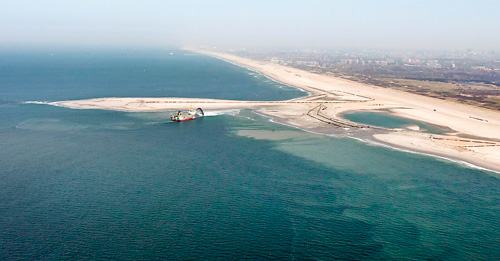KIJKDUIN, Netherlands, (AFP) - In its age-old war to keep back the sea, low-lying Netherlands has dumped sand onto a surface larger than 200 football fields just off the coast -- and will wait for nature to do the rest.
The wind, waves and ocean currents are the next "engineers" in this innovative project that will see the transferred sand -- all 20 million cubic metres (700 million cu.ft.) of it -- driven landward to form a natural barrier against the North Sea's relentless onslaught.
 |
| A handout picture released by the Rijkswatersaat shows a dredger pushing sand onto the sand motor, a hook shaped peninsular of sand being built on the coast between Kijkduin and Ter Heijde. The Dutch authorities hope that the man made peninsular, which extends one kilometre out to sea will replenish the coast with sand that is eroded naturally. AFP |
"It's already working!" said an excited project coordinator Nico Bootsma as he stood seven metres (22 feet) above sea level at the hook-shaped peninsula's highest point. It's here, at the sandbar's northern edge, where waves are at their highest.
The elements have started moving the tip of the bar, which already almost touches land at low tide.
Over a period of 15 to 20 years, the sand will wash towards the coast, reinforcing beaches and existing sand dunes that help protect the Netherlands, more than a quarter of which lies below sea level.
"Under natural circumstances, the Dutch coast would erode away slowly," explained Leo Linnartz, an ecology expert who advised the project's developers on behalf of the World Wide Fund for Nature (WWF). Without reinforcing fragile shores, floods would eventually be inevitable, he said.
Over the decades, the Dutch have developed world-renowned expertise in the field of hydro-engineering, notably in constructing dams, dikes and bridges.
Work together with nature
Around 17,500 km (10,600 miles) of embankment have already been built along its coast and rivers.
The new project was conceived by a group of experts commissioned by the Dutch government to help solve the country's ongoing headache. It used dredgers to suck up ocean-floor sand 10 km off the coast then dump it closer to land. Some of the huge machines were able to carry as much as 10,000 cubic metres of sand at one time.
If the experiment works, the sandbar project, situated between the seaside suburbs of Kijkduin and Ter Heijde near The Hague, will be replicated elsewhere in the country.
The system could even be "exported", as many foreign delegations visiting the site have expressed interest in this new, simple solution.
"We used to do it (strengthening the coast) in such a way that we used a lot of stones and concrete and things like that," said Linnartz.
"But nowadays we prefer to work together with nature, to cooperate with natural forces." The idea of strengthening the coastline with sand is not new, said Linnartz. But placing it off the coast and allowing nature to take its course is not only a fresh approach to the problem but less harmful to the environment than simply dumping more sand on the dunes, he said.
Yet every time sand is moved in great quantities, ecosystems are disturbed, whether in the sea or on beaches and dunes, he noted.
While traditional shoring up happens around every five years, the new plan based on the sand's natural movement will last 15 to 20 years, allowing nature to recover in the long run.
According to Linnartz, the fact the sandbar was built up over a "limited" area -- about 200 hectares (500 acres) -- as opposed to dozens of kilometres of direct enforcement along the dunes was also more cost-effective.
"The sandbar has the shape of a hook because it is the most natural form," added Bootsma, saying the choice of a peninsula, rather than an island, was made to give the public easy access for daily use by strollers, wind surfers and surfers alike.
But it is not only human visitors who will benefit from the newly-created marine playground. Nearby a flock of birds frolicked peacefully around a small artificially created interior lake. |


